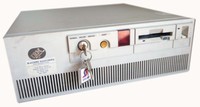IBM RS/6000 320
| Home > Browse Our Collection > Computers > IBM > IBM RS/6000 320 |
|
RISC System/6000, or RS/6000 for short, is a family of RISC and UNIX based servers, workstations and supercomputers made by IBM in the 1990s. The RS/6000 family replaced the IBM RT computer platform in February 1990 and was the first computer line to see the use of IBM's POWER and PowerPC based microprocessors. RS/6000 was renamed eServer pSeries in October 2000 The IBM RS/6000 320 is a powerful multi-user, multi-tasking, desktop computing system. The 320 is based on IBM's Performance Optimization With Enhanced RISC (POWER) Architecture and is designed for balanced system performance providing a high-speed floating-point processor with concurrent instruction execution. It features a 20MHz CPU and contains 8MB to 128MB of memory and 160-MB to 800-MB internal disk. Multiple distributed I/O processors are used to further enhance system performance by off loading the CPU I/O control processing of high-performance devices. It can be installed in either a vertical or horizontal position. The 320 offers flexibility with a wide variety of optional features and input/output devices to provide increased function, connectivity and price performance with the AIX* Version 3 for RS/6000. Desktop Model with both vertical or horizontal orientation "The IBM RS/6000 320 is a powerful multi-user, multi-tasking desktop systems combining high function, expansion capabilities, and outstanding price/performance. The systems can be installed in either a vertical or horizontal position to conserve desk space. A pedestal is provided for stabilization in the vertical position and is mounted on the bottom of the system unit when in the horizontal position. The 320 is a multi-purpose, desktop systems for commercial and scientific environments. The 320 is a the IBM RS/6000 entry server systems and are suitable for a variety of file server, compute server and multi-user ASCII terminal applications. The 320 and 320H have optional graphics features. IBM RS/6000 systems can be used either as a stand-alone graphics workstation or configured as a LAN-dependent "client system". Designed around IBM's POWER Architecture, the system unit contains a Processor Board, System Board, Memory Board, Power supply, Cooling fans, Clock Battery, Disk, Diskette Drive and Operator Panel. The 320 contains a 20 MHz microprocessor chip set and 8MB of memory is standard. The system may be configured up to 128MB (maximum) of memory. A combination of 8, 16, 32 or 64MB memory cards, up to a maximum of two cards may be installed. As a select feature, the base system may be ordered with 16, 32 or 64MB of memory in place of the first 8MB of memory. The 320H CPU contains a 25 MHz microprocessor chip set and 16MB of memory is standard. The system may be configured up to 128MB (maximum) of memory. A combination of 8, 16, 32, or 64MB memory cards, up to a maximum of two cards may be installed. As a select feature, the base system may be ordered with 32 or 64MB of memory in place of the first 16MB of memory. The CPU contains an 8KB two-way set-associative instruction cache and a 32KB four-way set-associative data cache. It also supports separate 64-bit memory to data cache, 32-bit fixed-point to data cache and 64-bit floating-point to data cache buses for fast data transfer between the CPU and memory for a balanced system performance. Dedicated I/O processors are used on many of the high performance I/O adapters to enhance overall system performance. Reliability, availability, and serviceability are key considerations in the design of the RS/6000 systems. CPU chips have data parity in their data paths and on internal arrays, CPU chip to chip data busses have parity, and the Micro Channel bus supports parity on some adapters. CPU chips implement a unique built-in self test to detect CPU errors during power up. The memory subsystem is also tested extensively during power up. The memory subsystem provides ECC (Error Correction Code) designed to detect double bit errors and detection and correction of single bit errors. Memory Control also supports hardware assisted memory scrubbing for removal of soft failures. Standard Features: One 8MB Memory Card on the 320 One 1.44MB 3.5-inch Diskette Drive One 160MB 3.5-inch Internal Direct Attached Disk Drive* on the 320 Four Micro Channel Feature Card Slots are available for expansion (Three are available on the 320H, one slot is used for the SCSI card) Standard Device Ports/Connectors: Keyboard/Speaker Mouse Tablet Two Serial Ports Parallel Printer Port Our model was kindly donated by Robert Burford Manufacturer: IBM Comment on This Page IBM RS/6000 320 Manuals:
Magazines RELATED to IBM RS/6000 320 in our Library
Other Systems Related To IBM RS/6000 320:This exhibit has a reference ID of CH16193. Please quote this reference ID in any communication with the Centre for Computing History. |
Click on the Image(s) For Detail
|
























